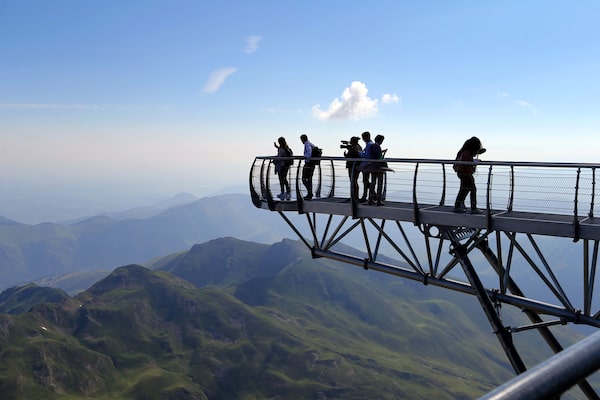Besides cooler temperatures, the arrival of fall brings another damper for travellers in the Northern Hemisphere: shorter days. But looked at differently, longer nights offer a chance to indulge in astrotourism, one of the year’s hottest travel trends.
Even if a summer jaunt to Europe isn’t yet a distant memory, you didn’t see the continent like this, as darker and clearer skies (cold air holds less moisture, so haze is reduced) improve the chances you’ll see awe-inspiring astronomical sights overhead. From a haven of darkness in the heart of Germany to a mountaintop in France or a road trip detour-worthy spot in Ireland, here are some of Europe’s best dark-sky destinations to explore.
Westhavelland Nature Park, Germany
Just 70 kilometers from the bustling and brightly lit German capital city of Berlin, Westhavelland Nature Park is one of the most easily accessed dark-sky destinations in Europe and as a result it was certified as a Dark Sky Reserve by the International Dark Sky Association in 2014.
Also known as Sternenpark Westhavelland (Westhavelland Star Park), it hosts monthly public observation nights and lectures for visitors, as well as infrequent special events such as astrophotography workshops and night sky hikes. Many of these are so popular they book out several months in advance even in the fall months. Note, however that, most are offered only in German. Open year-round; an events calendar is available on the Westhavelland Nature Park website.
Pic du Midi, France
The Pic du Midi Observatory sits high on Pic du Midi de Bigorre in the French Pyrenees. This mountaintop observatory, located at 2,877 metres above sea level was opened in 1908. The high elevation helps reduce atmospheric pollution for both the astronomers who observe from the facility’s eight telescopes, as well as visitors who come to spend an evening or night under the sprawling sky overhead.

A suspended glass walkway overlooking the French Pyrenees mountains at the Pic du Midi observatory in Bagneres-de-Bigorre.BOB EDME/Getty Images
The best way to visit Pic du Midi is for a Nuit au Sommet, which includes cable-car transfer to the summit, accommodation for the night and an extended guided stargazing session (available year-round). During autumn and winter months, the snow-covered peaks of the Pyrenees reflect the moonlight creating an even more dramatic scene as the stars whirl overhead. Open year-round. Reserve a double room from €439 ($632).
Lauwersmeer, Netherlands
If you’re in search of dark skies in Holland, head to the coastal north. Since 2016, Lauwersmeer National Park has also been a certified dark-sky park by the International Dark Sky Association, protecting a core zone of darkness in one of Europe’s most light polluted countries.

During winters, Lauwersmeer National Park is ideal for seeing the Northern Lights.Patrick_Gijsbers/iStockPhoto / Getty Images
By day, Lauwersmeer is a birding destination, especially in the cooler fall months as migratory species such as the tundra swan and barnacle goose arrive to make the waterways their winter home. It’s during this time that the park is also ideal for trying to see the Northern Lights. If the skies are clear and the solar activity is strong enough, the aurora will appear low on the northern horizon. Open year-round. The Dutch Forestry Commission Staatsbosbeheer has an events calendar which includes organized astronomical events.
Kerry Dark Sky Park, Ireland
Away from the bright lights of Dublin, Kerry Dark Sky Park is located on the far southwestern coast of Ireland. The park was certified as a dark-sky reserve in 2014, making it the country’s first designated dark-sky destination. Since then, a committed band of local astronomers and enthusiasts have helped protect the night sky through conscientious light management as roadtrippers on Ireland’s Wild Atlantic Way and Ring of Kerry routes detour to see the stars here.
Plan a stop at the Kerry Dark Sky Tourism office near Ballinskelligs before heading toward the coast to find the best view; the Kerry Cliffs Portmagee is an ideal spot to watch the sunset followed by stargazing. Open year-round but the summer months are more likely to offer clear skies. Kerry Dark Sky Tourism offers guided stargazing options on request.
Jokulsarlon Glacier Lagoon, Iceland
Iceland is one of the world’s top aurora destinations. Most people travelling for that reason plan a trip during the frigid, dark winter, but the months around the autumnal equinox are actually better for seeing the Northern Lights in terms of both solar activity and how the Earth’s axial tilt affects the intensity.

Jokulsarlon Glacier Lagoon is an ideal foreground for a night of enjoying aurora if they are visible.franckreporter
Located in southern Iceland along the Golden Circle route, Jokulsarlon Glacier Lagoon borders Vatnajokull National Park, a popular adventure spot for hiking, ice climbing and caving. With vibrant blue icebergs floating in the lake, Jokulsarlon is also an ideal foreground for a night of enjoying the stars or aurora if they are visible. Use the nearby town of Hof as a base to explore the region by both day and night. Open year-round. Inquire and reserve in advance for accommodation in Hof or nearby communities.
Live your best. We have a daily Life & Arts newsletter, providing you with our latest stories on health, travel, food and culture. Sign up today.